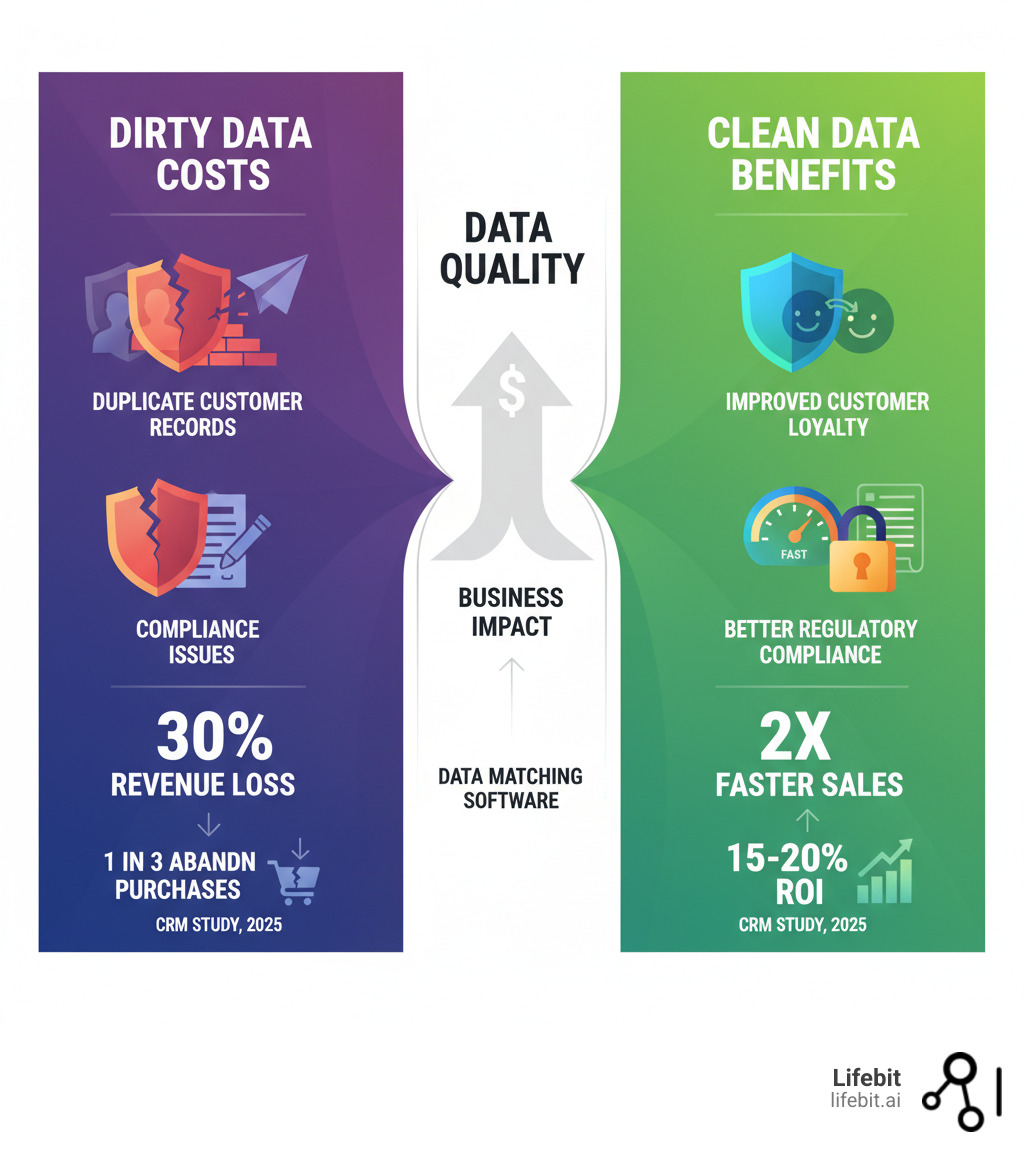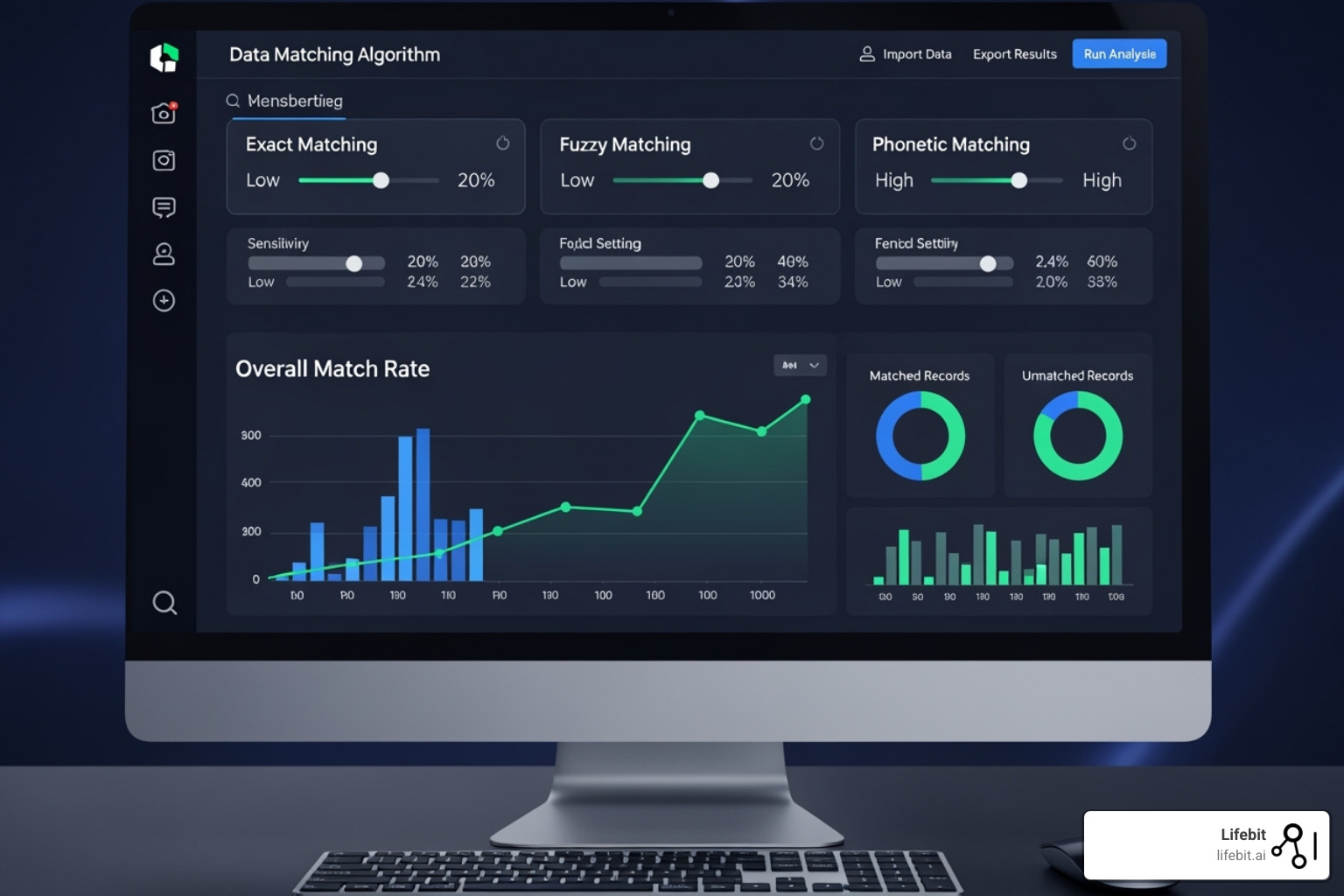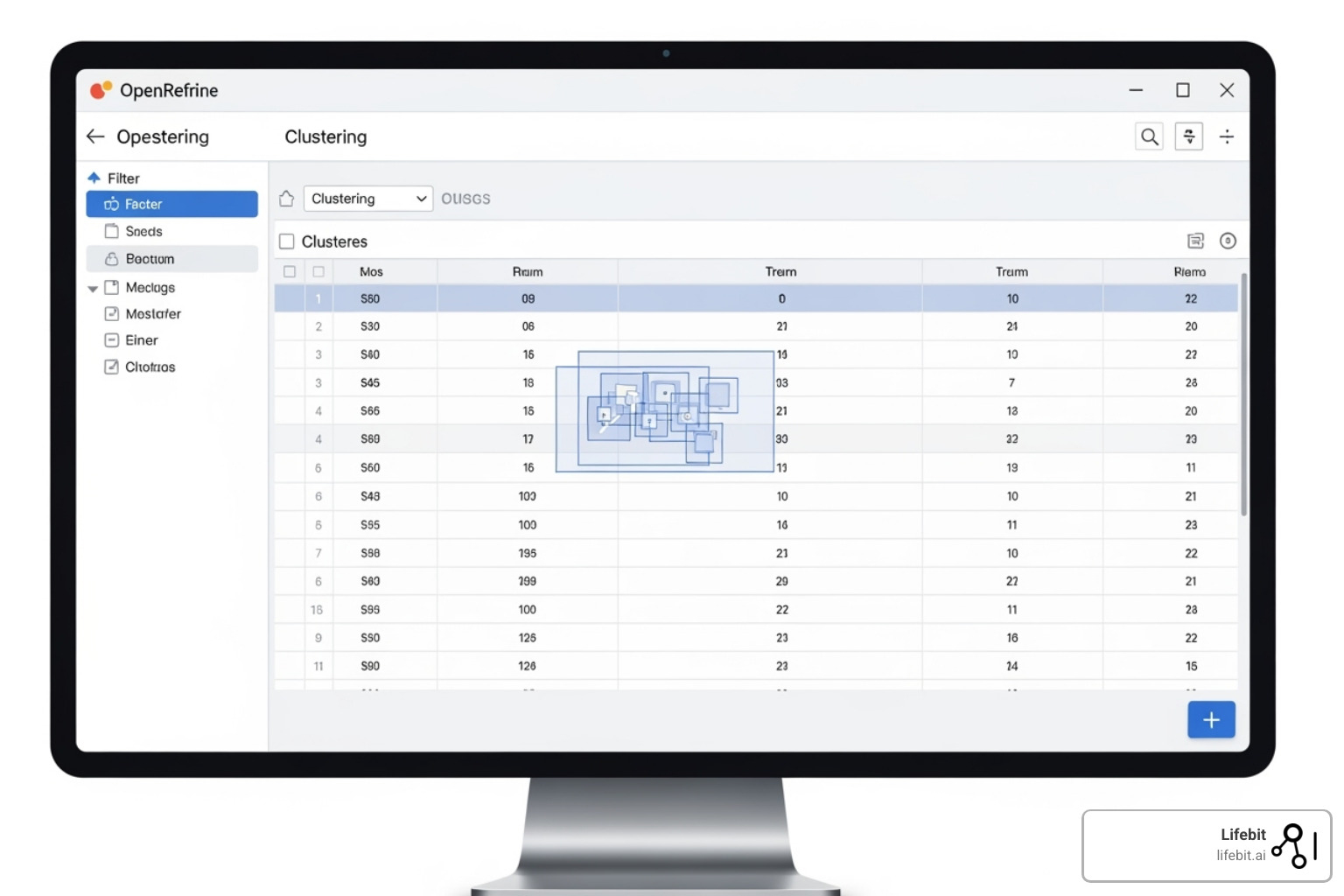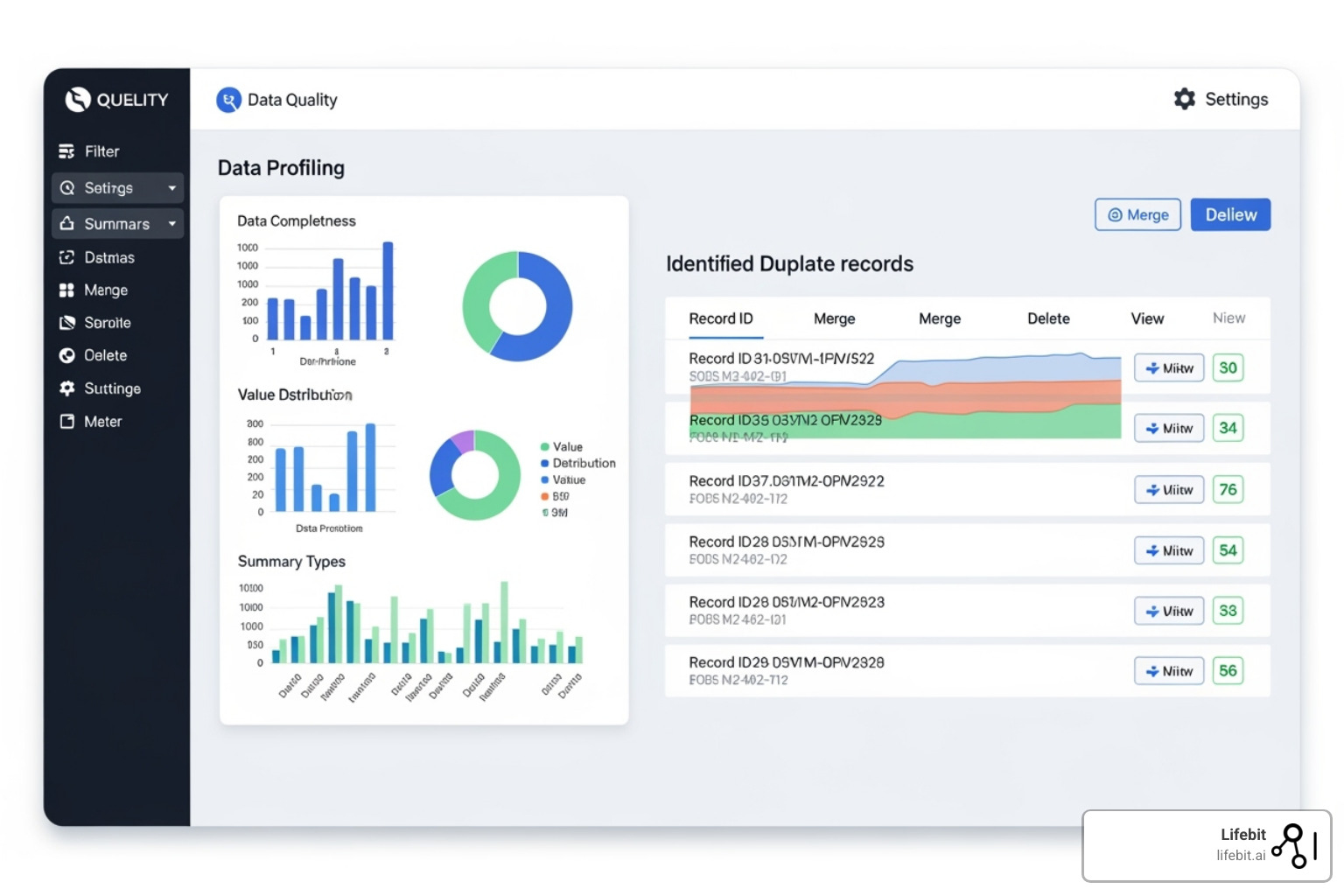Unlock Your Data’s Potential: A Comprehensive List of Free Data Matching Software

Why Clean Data is Your Most Valuable Asset
Data matching software freeware offers organizations a cost-effective way to tackle one of their biggest challenges: messy, duplicate, and inconsistent data that undermines critical business decisions. Your CRM might not be broken, just bloated with duplicates, misspelled names, and leads that show up twice – once as “Faisal Khan,” and again as “F. Khan.”
Top Free Data Matching Software Tools:
- OpenRefine – Powerful open-source tool for data cleaning and change
- Febrl – Specialized for biomedical record linkage with probabilistic matching
- dirty-cat – Python library for handling messy categorical data with ML
- JedAI – Comprehensive toolkit for entity resolution and data integration
- Zingg – ML-powered entity resolution with scalable architecture
- Datablist – User-friendly online tool with no-code approach
- WinPure Community Edition – Robust desktop solution with GUI interface
The stakes are higher than you might think. A study analyzing over 1 million CRM records found a strong link between better data quality and increased purchase loyalty. For pharmaceutical companies, public health organizations, and regulatory bodies working with diverse datasets from EHRs, claims data, and genomics, poor data quality creates bottlenecks that slow down critical research and decision-making.
Data matching – also called record linkage, deduplication, or entity resolution – is the process of identifying and linking related records within or across datasets. It’s essential for creating single views of patients, standardizing clinical data, and ensuring regulatory compliance across federated environments.
I’m Maria Chatzou Dunford, CEO and Co-founder of Lifebit, where I’ve spent over 15 years working with computational biology, AI, and biomedical data integration challenges that require sophisticated data matching software freeware solutions. My experience building tools for precision medicine has shown me how the right data matching approach can transform siloed, messy datasets into actionable insights for drug findy and patient care.

At its core, data matching is about bringing together information from two or more records believed to belong to the same entity. This can involve linking data across multiple datasets (linkage) or matching data within a single dataset to remove duplicates (deduplication). The importance of this process for businesses cannot be overstated. Clean data literally keeps customers coming back, reduces operational costs, and ensures that our analyses are built on a solid foundation. Without it, even the most advanced AI and analytics tools are operating on flawed assumptions, leading to wasted marketing spend, incorrect sales outreach, and compliance issues.
Choosing the Right Tool: Key Features of Free Data Matching Software
Finding the perfect data matching software freeware feels a bit like shopping for a car – you need to know what features matter most before you start test-driving options. The good news? Understanding the core capabilities will help you choose a tool that actually solves your data problems instead of creating new ones.
Let’s start with the heart of any data matching tool: matching algorithms. Think of these as different approaches to solving the same puzzle. Exact matching works perfectly when your data is pristine – every character matches precisely. But let’s be honest, when was the last time you saw truly clean data? That’s where fuzzy matching becomes your best friend, using clever algorithms like Levenshtein Distance to catch those pesky typos and variations like “Main St.” versus “Main Street.”
Phonetic matching takes this a step further, identifying records that sound alike but look different – perfect for catching “Smith” and “Smyth” as the same person. The most sophisticated tools combine these approaches into hybrid matching, blending deterministic rules with probabilistic logic to achieve higher accuracy.

Data source compatibility is where rubber meets the road. Your data probably lives everywhere – CSV files, Excel spreadsheets, SQL databases, maybe even cloud storage like MS Azure. The best free tools handle this diversity gracefully, offering connectors that let you work with multiple formats without the headache of constant file conversion.
Scalability often separates the wheat from the chaff in free tools. While many freeware options have limitations, some handle datasets with several hundred thousand records efficiently using techniques like “blocking” to reduce computational overhead. Febrl, for instance, manages datasets of this size quite well for academic and research purposes.
The user interface question boils down to your team’s technical comfort level. A graphical user interface makes data matching accessible to business users and analysts who prefer point-and-click simplicity. But if you’re building automated workflows, command-line interfaces and API access offer the flexibility to integrate matching processes into larger data pipelines.
Automation capabilities become crucial when you’re dealing with regular data updates. The ability to schedule matching jobs or trigger them through APIs transforms a one-time cleanup into an ongoing data quality strategy. This is especially important in biomedical research where new data constantly flows in from multiple sources and maintaining data integrity is critical for regulatory compliance.
The Top 7 Free Data Matching Software Tools in 2025
Now that we understand what features matter most, let’s explore the data matching software freeware tools that can actually solve our messy data problems. I’ve tested dozens of options over the years, and these seven stand out for their unique strengths and real-world capabilities.
Each tool brings something different to the table – whether you’re a Python developer, a business analyst, or someone who just needs to clean up a customer database without writing code. Let’s explore what makes each one special.
OpenRefine: The Powerhouse for Messy Data
When I first finded OpenRefine, it felt like finding a Swiss Army knife for data cleaning. This open-source powerhouse handles the kind of messy data that makes other tools throw up their hands in defeat.
What sets OpenRefine apart is its faceting system – imagine being able to slice your data into meaningful chunks and see patterns you never noticed before. The clustering feature is pure magic for fixing inconsistencies. It’ll automatically group “New York,” “NY,” and “New York City” together, saving hours of manual cleanup.
The reconciliation capabilities let you match your local data against external databases like Wikidata. But here’s what I love most: OpenRefine processes everything locally on your machine. Your sensitive data never touches the cloud, which is crucial when dealing with patient records or confidential business information.

Best for: Journalists, researchers, and anyone who needs powerful data cleaning without coding expertise. The infinite undo/redo feature means you can experiment fearlessly.
Febrl: Specialized Biomedical Record Linkage
Febrl might have a quirky name (Freely Extensible Biomedical Record Linkage), but don’t let that fool you. This Python-based tool was built specifically for the challenges we face in healthcare data – linking patient records across systems that don’t talk to each other.
What makes Febrl special is its focus on probabilistic record linkage. Instead of demanding exact matches, it calculates the likelihood that two records belong to the same person, even when dealing with nickname variations, married name changes, or data entry errors.
The tool handles data standardization and segmentation beautifully, and it’s designed to work with datasets containing up to several hundred thousand records. While it requires some Python knowledge, the learning curve pays off when you’re dealing with complex biomedical data integration.
Best for: Academic researchers, especially in biomedical fields, and anyone wanting to truly understand probabilistic record linkage techniques. Check out the FEBRL project page for documentation and examples.
dirty-cat: The Python Library for Messy Categorical Data
If you’re a Python developer dealing with categorical data that looks like it went through a blender, dirty-cat is your new best friend. This machine learning-focused library excels at handling the kind of messy categorical variables that break traditional ML pipelines.
The fuzzy joining capabilities are particularly impressive – you can join tables even when column values don’t match exactly. Think joining a customer database where one system has “Inc.” and another has “Incorporated.” The library handles morphological variants and typos with ease, making your data ML-ready without extensive preprocessing.
What I appreciate about dirty-cat is how it integrates seamlessly into existing data science workflows. You’re not switching between tools – just importing another Python library. The fuzzy joining example on their site shows exactly how powerful this approach can be.
Best for: Python developers and data scientists who need to prepare messy categorical data for machine learning models.
JedAI: A Comprehensive Open Source Toolkit
JedAI takes a different approach – instead of focusing on one aspect of data matching, it provides a comprehensive toolkit that covers the entire entity resolution workflow. This schema-agnostic solution adapts to whatever data structure you throw at it.
The modular architecture is brilliant for complex projects. You can mix and match different blocking strategies, similarity measures, and classification techniques depending on your specific needs. It supports both supervised and unsupervised learning approaches, making it incredibly versatile.
What impressed me most about JedAI is its ability to handle large-scale data integration scenarios that would overwhelm simpler tools. The research team behind it clearly understands the real-world complexity of entity resolution.
Best for: Researchers, data engineers, and anyone tackling complex, large-scale entity resolution projects. Visit the JedAI project homepage to explore its full capabilities.
Zingg: ML-Powered Entity Resolution
Zingg represents the new generation of machine learning-powered entity resolution tools. It combines the best of supervised learning and unsupervised learning to create unified views from scattered data sources.
What makes Zingg exciting is its modern approach to scalability. It connects to everything – local files, cloud storage, enterprise applications – and handles formats that would stump older tools. I’ve seen it successfully match records that include numerical arrays and even image comparisons with proper setup.
The tool is designed for building unified views at scale, which is exactly what we need in federated data environments. The active community provides excellent support through their Zingg community support Slack channel.
Best for: Data engineers and data scientists focused on building scalable, unified data views using cutting-edge machine learning techniques.
Datablist: User-Friendly Online Data Matching
Sometimes you just need to clean data quickly without installing software or writing code. That’s where Datablist shines with its no-code, browser-based approach to data matching.
The interface is refreshingly simple – upload your data, configure your matching rules, and let the smart matching algorithms do their work. It handles exact match, phonetic, and advanced fuzzy matching without requiring any technical expertise.
The generous free plan makes it perfect for testing and smaller projects. Plus, it works across different operating systems since it’s entirely web-based. You can jump right in at Open Datablist tool and start matching data immediately.
Best for: Marketing and sales teams, small businesses, and anyone needing quick, user-friendly data matching for datasets under one million records.
WinPure Clean & Match Community Edition: A Robust Freeware Option
WinPure’s Community Edition proves that data matching software freeware can be both powerful and user-friendly. This desktop tool brings enterprise-level capabilities to anyone willing to download and install it.
The data profiling features give you instant insights into your data quality issues, while the out-of-the-box connectors handle everything from simple spreadsheets to complex enterprise systems. The duplicate detection presents individual similarity scores, letting you make informed decisions about which records to merge.
What sets WinPure apart is its knowledge base library system – it learns from your matching decisions and gets more accurate over time. The interface strikes the perfect balance between sophistication and usability.

Best for: Business users, data analysts, and small teams who need powerful desktop software with an intuitive interface for comprehensive data quality management.
Freeware vs. Enterprise: Understanding the Trade-offs of Data Matching Software Freeware
Choosing between data matching software freeware and enterprise solutions feels a bit like deciding between cooking at home versus dining at a fancy restaurant. Both can satisfy your hunger, but the experience, convenience, and capabilities are worlds apart.

The decision isn’t always straightforward. While freeware can be incredibly powerful and cost-effective, it comes with trade-offs that might surprise you. Let’s explore both sides honestly, so you can make the best choice for your specific situation.
Advantages of Using Data Matching Software Freeware
The appeal of free tools goes far beyond just saving money. Zero cost is obviously the biggest draw – there’s no budget approval needed, no procurement process, and no monthly fees eating into your resources. This makes freeware incredibly budget-friendly for startups, research projects, or any organization working with tight financial constraints.
But the benefits run deeper than just economics. Freeware is ideal for small projects where you need to clean up a dataset quickly or experiment with different matching approaches. Think of it as your data quality sandbox – you can try different algorithms, test various settings, and learn what works best for your specific data without any financial risk.
The learning opportunities are exceptional. Many open-source tools come with active communities where you can ask questions, share experiences, and learn from others who’ve tackled similar challenges. It’s like having a global study group focused on data quality.
Flexibility is another major advantage, especially with open-source options. You can peek under the hood, modify the code to fit your exact needs, or integrate it seamlessly into your existing workflows. This level of customization is often impossible with commercial tools that keep their algorithms locked away.
Limitations and Disadvantages of Data Matching Software Freeware
Here’s where reality sets in. Limited scalability is often the first wall you’ll hit. While tools like Febrl can handle several hundred thousand records beautifully, they start to struggle when you’re dealing with millions of records. Processing times can stretch from minutes to hours, or worse, the system might crash entirely.
Lack of dedicated support can be frustrating when you’re facing a deadline. Instead of calling a support hotline, you’re searching through forums, reading documentation, or hoping someone in the community has faced your exact problem before. This works fine for learning projects but can be stressful for critical business processes.
The fewer advanced features limitation becomes apparent when you need sophisticated capabilities. Enterprise solutions often offer real-time processing, advanced AI-driven matching, comprehensive audit trails, and specialized algorithms for specific industries. Freeware typically focuses on core functionality rather than these bells and whistles.
Security vulnerabilities deserve serious consideration, especially if you’re working with sensitive data. While open-source transparency can be a security advantage, it also means potential vulnerabilities are visible to everyone. Not all freeware projects undergo the rigorous security testing that commercial software receives.
Infrequent updates can leave you stuck with outdated software. Volunteer-driven projects sometimes lose momentum when key contributors move on to other interests. This can mean slower bug fixes, compatibility issues with newer systems, and features that never quite get finished.
The reality is that data matching software freeware works brilliantly for many scenarios – learning, small projects, specific use cases, and organizations with technical expertise to handle the limitations. However, as your data volumes grow and your requirements become more complex, the trade-offs start tilting toward enterprise solutions that offer guaranteed support, advanced features, and the scalability to handle whatever your organization throws at them.
Best Practices for Implementing Your Free Data Matching Solution
Even with the best data matching software freeware, success isn’t guaranteed without a thoughtful approach. Think of it like cooking – having great ingredients doesn’t automatically make a great meal. You need the right recipe, proper technique, and careful attention to detail.
The difference between a successful data matching project and a frustrating one often comes down to preparation and strategy. Let’s walk through how to set yourself up for success.

A Step-by-Step Implementation Guide
The key to successful data matching lies in following a structured approach that puts your business needs first, not the technology.
Start by defining what success looks like – and make it measurable. Before you even download a tool, ask yourself: Are we trying to reduce duplicate CRM records by 80%? Improve marketing campaign accuracy by 15%? Create a unified patient view across multiple systems? These concrete goals will guide every decision you make and help you prove ROI later.
Clean your data first, match it second. This is perhaps the most important rule in data quality work. As we say in the business: garbage in, garbage out. Attempting to match dirty data is like trying to organize a messy closet in the dark – you’ll just make a bigger mess.
Use data profiling tools to identify inconsistencies, misspellings, and formatting issues before you start matching. Normalize names, addresses, and company names to ensure uniformity. For example, standardize “St.” to “Street” and “Inc.” to “Incorporated” before running your matching algorithms.
Design your matching rules thoughtfully rather than blindly trusting the algorithm. While fuzzy matching algorithms are powerful, you need to understand how your chosen tool thinks. If it uses Levenshtein Distance for string similarity, learn what that means for your specific data.
Create custom rules that reflect your business reality. When deduplicating customers, you might use exact matching on email addresses, fuzzy matching on full names, and phonetic matching on last name plus city. Assign weights to different fields based on their reliability and importance.
Involve business users early and keep them engaged throughout the process. Your IT team might run the tool, but sales, marketing, and customer support teams will live with the results. Their domain expertise is invaluable – they know that “Johnson & Johnson” and “J&J” refer to the same company, or that certain address variations are common in your industry.
Implement human-in-the-loop review for critical decisions. For matches with confidence scores below a certain threshold, human review isn’t optional – it’s essential. This prevents false positives (incorrectly merging records) which can be more damaging than missed matches. Build workflows that let reviewers quickly confirm, reject, or modify potential matches.
Make your process repeatable and sustainable. Data is constantly changing, so your matching efforts shouldn’t be a one-time event. Establish standardized workflows with clear thresholds, change logs, and rollback mechanisms. This ensures ongoing data quality and makes it easier to train new team members.
Security and Privacy Considerations
Using data matching software freeware requires extra attention to security and privacy, especially when working with sensitive biomedical or patient data.
Consider data residency and processing location carefully. Many freeware tools like OpenRefine process data on your local machine, which is a significant privacy advantage. Your data never leaves your controlled environment or gets uploaded to third-party cloud services. For sensitive healthcare or genomic data, this local processing approach can be crucial for compliance.
Handle PII and PHI with extreme care. When working with personally identifiable information or protected health information, you must ensure your chosen tool complies with relevant regulations like GDPR, HIPAA, or CCPA. If a tool requires uploading data to the cloud, thoroughly investigate its security measures, encryption practices, and data retention policies.
Review open-source licenses to understand your obligations. While most allow free use, some may have requirements about modifications or redistribution that could affect your organization.
Implement strong data encryption and access controls regardless of whether you’re using freeware or enterprise tools. Encrypt data both in transit and at rest. Set up robust access controls for both your data sources and the matching tools themselves.
Stay current with security updates for open-source tools. Monitor project communities and GitHub repositories for reported vulnerabilities. Regular updates to the latest software versions help protect against known security issues.
At Lifebit, we’ve seen how proper implementation of data matching practices can transform fragmented biomedical datasets into unified, actionable resources for drug findy and patient care. The same principles apply whether you’re working with clinical trial data, genomic information, or traditional business records. The key is always to start with clear goals, involve the right people, and never compromise on security.
Conclusion: From Messy Data to Actionable Insights
We’ve taken quite a journey through data matching software freeware, haven’t we? From understanding why clean data is your secret weapon to exploring seven powerful free tools that can transform your messy datasets into gold mines of insight.
Think about it – we started with the sobering reality that dirty data costs businesses real money and undermines even the smartest decisions. But we’ve also finded that you don’t need a massive budget to tackle this challenge. Whether you’re a researcher working with OpenRefine’s privacy-focused local processing, a Python developer leveraging dirty-cat’s machine learning capabilities, or a business user finding success with WinPure’s intuitive interface, there’s a data matching software freeware solution that fits your needs.
The tools we’ve explored prove that powerful data quality solutions are within everyone’s reach. Yes, freeware has its limitations – you might hit scalability walls or miss the hand-holding of dedicated support. But for small teams, researchers, and organizations just starting their data quality journey, these free tools offer an incredible foundation to build upon.
Here’s what really matters: clean, matched data is the foundation that makes everything else possible. Your AI models, your analytics dashboards, your customer insights – they’re only as good as the data feeding them. Without proper data matching and integration, even the most sophisticated analysis becomes unreliable guesswork.
At Lifebit, we see this challenge every day in the biomedical world. Researchers and pharmaceutical companies are sitting on treasure troves of genomic data, electronic health records, and clinical trial information. But when that data is fragmented, inconsistent, or poorly matched across systems, breakthrough findies get buried in the noise.
That’s why we built our federated AI platform – to securely harmonize and analyze global biomedical and multi-omic data at scale. We understand that whether you’re using free tools or enterprise-grade solutions, the goal is the same: changing scattered, messy data into a unified source of truth that drives real-world impact.
The principles we’ve covered – from choosing the right matching algorithms to implementing human-in-the-loop reviews – apply whether you’re cleaning a small customer database or integrating massive healthcare datasets. Start with the free tools, learn the fundamentals, and scale up as your needs grow.
Ready to see how advanced data integration can open up insights from complex biomedical data? We invite you to explore our federated data platform and find more info about our platform. Let’s work together to turn your data challenges into competitive advantages.

